| Columns Retired Columns & Blogs |
Velodyne DF-661 loudspeaker Page 2
Fig.1 shows the spectrum of the Velodyne reproducing a 100Hz sinewave at 2.83V, equivalent to just under 1W. The spike reaching 0dB at 100Hz is the fundamental; two additional spikes at 100Hz and 150Hz can also been seen. These are the second and third harmonics: while higher than specified, at a little above –56dB, 0.15%, these are still very low in absolute terms. For comparison, fig.2 shows the spectrum of the B&W Silver Signature reproducing a 100Hz tone at the same 2.83V level. The second harmonic here is more than four times as high as that of the DF-661, reaching the –40dB level, or 1%. Even if you drive the Velodyne significantly harder (fig.3, 8.95V, 9.65W), its distortion harmonics remain low in level (though the port did produce an audible "chuffing" noise at this level).
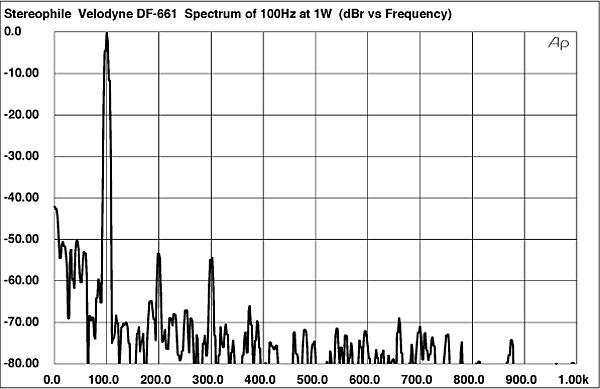
Fig.1 Velodyne DF-661, spectrum of 100Hz sinewave, DC–1kHz, 2.83V drive signal (linear frequency scale, 10dB vertical div.).
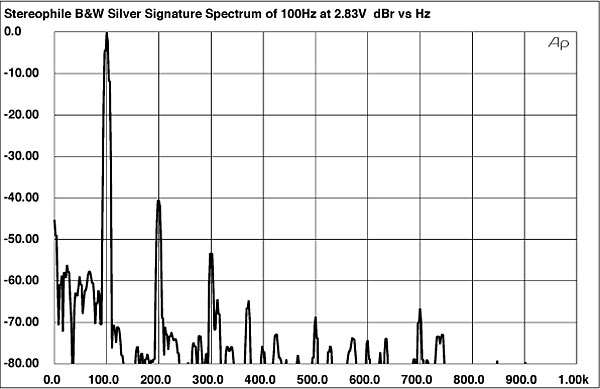
Fig.2 B&W Silver Signature, spectrum of 100Hz sinewave, DC–1kHz, 2.83V drive signal (linear frequency scale, 10dB vertical div.).
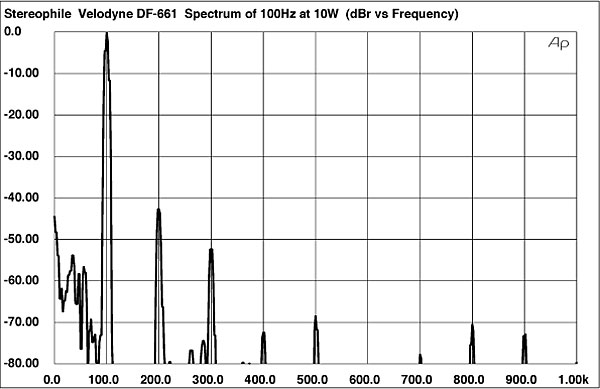
Fig.3 Velodyne DF-661, spectrum of 100Hz sinewave, DC–1kHz, 8.95V drive signal (linear frequency scale, 10dB vertical div.).
Drive-unit distortion is related to diaphragm excursion, which will be lower at high frequencies. Increasing the drive-signal frequency should therefore result in lower levels of distortion. This can be seen for both loudspeakers in the tables and in figs.4 and 5. The B&W is still producing much higher distortion than the Velodyne. Its predominant harmonic, the third at 3kHz, an octave-and-a-fifth above the fundamental, lies at around 0.5%, which is more than 20dB higher in level than the DF-661's; I found it to be just audible with the pure tone. (Note that, by conventional loudspeaker standards, this distortion is still quite low.)
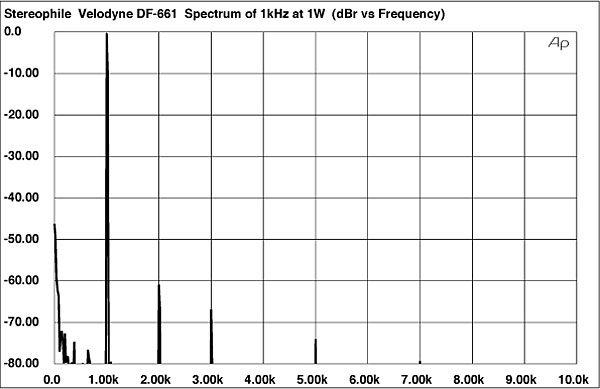
Fig.4 Velodyne DF-661, spectrum of 1kHz sinewave, DC–10kHz, 2.83V drive signal (linear frequency scale, 10dB vertical div.).
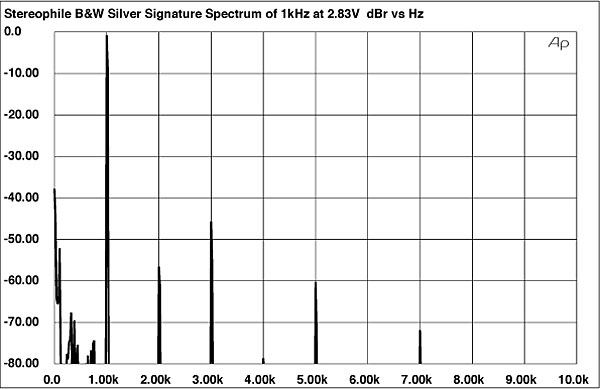
Fig.5 B&W Silver Signature, spectrum of 1kHz sinewave, DC–10kHz, 2.83V drive signal (linear frequency scale, 10dB vertical div.).
The Velodyne's dominant harmonic was the more innocuous second, but even this was below –60dB at this power level (just under 1.6W). Increasing the power to 16W (fig.6) raised the level of the Velodyne's second harmonic to just –57dB, 0.14%, this still astonishingly low in level.
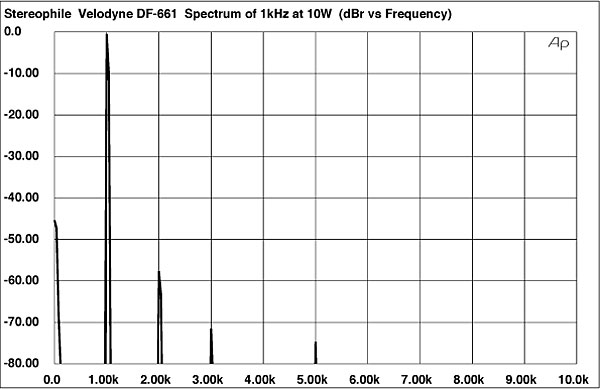
Fig.6 Velodyne DF-661, spectrum of 1kHz sinewave, DC–10kHz, 8.95V drive signal (linear frequency scale, 10dB vertical div.).
When it comes to the minimizing of non-linear distortion, the Velodyne DF-661 is a remarkable loudspeaker. What is the implication of this performance on its sound quality?
Sound
Unfortunately, not a lot. As promising as I feel the DF-661's drive-unit technology to be, I was very disappointed in its overall sound quality. Imaging seemed laterally precise, but there was insufficient soundstage depth. There was no low or midbass at all, which endowed the speaker with a very lightweight character. The lower midrange—the power region of orchestral sound—sounded lean and lacking in clarity. And the upper midrange sounded both too forward in level and too aggressive at anything other than moderate listening levels. Playing a recording already too bright in its intrinsic tonal balance—Queen's Live at Wembley '86 (Hollywood HR-61104-2), for example—was an unpleasant experience on the Velodynes.
As to the benefits of Velodyne's Distortion-Free design philosophy, I couldn't get past the DF-661's departure from a flat response—its linear distortion, if you will—to hear them.
Nothing I did regarding setup and room positioning made any fundamental difference to the speaker's sound. I won't go any further other than to note that, as a number of the magazine's equipment reviewers were visiting Santa Fe at various times during the review period, I took the opportunity to play the Velodynes for them. None disagreed with my assessment of the DF-661, though J. Gordon Holt did remark that if you listened through the speaker's tonal balance problems, it did sound very detailed, with an excellent transient response and clean high treble. He did note a slight nasality, however.
Conclusion
When he visited Santa Fe, Velodyne's David Hall offered the opinion that a flat frequency response was overrated as an indicator of sonic quality: "If you can lower distortion, you can tolerate greater departures in frequency response." While I wouldn't completely disagree with Mr. Hall—the Green Mountain Diamante that Steven Stone reviews in this issue, for example, has a non-flat on-axis response but still sounds musical—I would emphasize that a flat response remains a primary goal for the loudspeaker designer if it can be achieved without compromising other areas of performance.
Velodyne's DF-661 neatly illustrates what my colleague Thomas J. Norton terms "designer tunnel vision." Relatively often in the audio industry, one witnesses an engineer overachieving in one area of performance only to forget that a successful design involves striking a balance among all areas relevant to good sound quality (footnote 2). This oversight is understandable, given the marketing need for each company to distinguish itself from its competitors. Nevertheless, there is a much more neutral, much more musical-sounding loudspeaker waiting to be designed around Velodyne's very promising drive-unit technology, I feel.
Relaxing the harmonic-distortion spec would allow the series capacitor in the woofer feed to be eliminated and the woofer to be brought up significantly in level to better match the midrange. It would also allow the midrange to be crossed over to the tweeter an octave lower in frequency, at a more reasonable 2.5kHz, which would eliminate the speaker's beaminess in the mid-treble. The result of such changes would be, I feel, a much more musically acceptable sound. The downside, however, would be that the DF-661 could no longer claim to have the lowest non-linear distortion of any loudspeaker anywhere near its size and sensitivity.
As it stands, the DF-661 falls short of offering what I need from a loudspeaker. It may offer astonishingly low levels of harmonic distortion, but in my opinion, the DF-661's tonal balance departs too much from neutrality for it to be worth considering.
Footnote 1: In anything other than an anechoic chamber, the room's acoustics will have some effect on a loudspeaker's measured distortion. (If a harmonic falls at a frequency where the room arranges for there to be a deep notch at the microphone position, that harmonic effectively disappears. Conversely, if such a notch appears at the fundamental frequency, all the harmonics will appear incorrectly boosted in level.) By placing the microphone so close to the speaker under test, I hope to have minimized any such effects.
Footnote 2: The commercial success of Vandersteen loudspeakers owes much to Richard Vandersteen not forgetting this fact.
- Log in or register to post comments




































